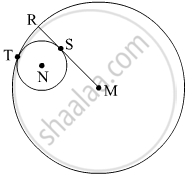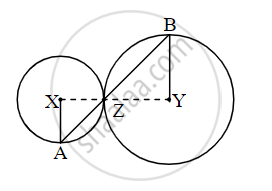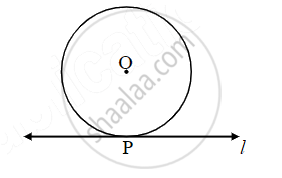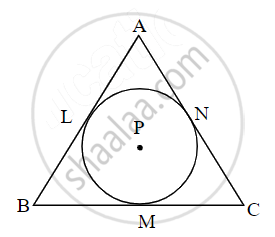Advertisements
Advertisements
Question
Two circles having radii 3.5 cm and 4.8 cm touch each other internally. Find the distance between their centres.
Solution 1
It is given that two circle having radii 3.5 cm and 4.8 cm touch each other internally.
We know, the distance between the centres of the circles touching internally is equal to the difference of their radii.
∴ Distance between the centres of the two circles = 4.8 cm − 3.5 cm = 1.3 cm
Thus, the distance between their centres is 1.3 cm.
Solution 2
Let the two circles having centres P and Q touch each other internally at point R.

Here, QR = 3.5 cm, PR = 4.8 cm
The two circles touch each other internally.
By theorem of touching circles,
P − Q − R
PQ = PR − QR ......[The distance between the centres of circles touching internally is equal to the difference in their radii]
= 4.8 – 3.5
= 1.3 cm
∴ The distance between the centres of the circles is 1.3 cm.
RELATED QUESTIONS
If two circles with radii 5 cm and 3 cm respectively touch internally, find the distance between their centres.
If two circles with radii 8 cm and 3 cm, respectively, touch internally, then find the distance between their centers.
Four alternative answers for the following question is given. Choose the correct alternative.
Two circles of radii 5.5 cm and 4.2 cm touch each other externally. Find the distance between their centres
Four alternative answers for the following question is given. Choose the correct alternative.
Two circles of radii 5.5 cm and 3.3 cm respectively touch each other. What is the distance between their centers ?
Four alternative answers for the following question is given. Choose the correct alternative.
Two circles intersect each other such that each circle passes through the centre of the other. If the distance between their centres is 12, what is the radius of each circle?
Four alternative answers for the following question is given. Choose the correct alternative.
A circle touches all sides of a parallelogram. So the parallelogram must be a, ______
How many common tangents can be drawn to two circles which touch each other internally?
(A) One (B) Two (C) Three (D) Four
In the given figure, circle with centre M touches the circle with centre N at point T. Radius RM touches the smaller circle at S. Radii of circles are 9 cm and 2.5 cm. Find the answers to the following questions hence find the ratio MS:SR.
(1) Find the length of segment MT
(2) Find the length of seg MN
(3) Find the measure of ∠NSM.

In the adjoining figure circles with centres X and Y touch each other at point Z. A secant passing through Z intersects the circles at points A and B respectively. Prove that, radius XA || radius YB. Fill in the blanks and complete the proof.

Construction: Draw segments XZ and YZ.
Proof:
By theorem of touching circles, points X, Z, Y are `square`.
∴ ∠XZA ≅ `square` ...(opposite angles)
Let ∠XZA = ∠BZY = a ...(I)
Now, seg XA ≅ seg XZ ...[Radii of the same circle]
∴∠XAZ = `square` = a ...[isosceles triangle theorem](II)
Similarly,
seg YB ≅ seg YZ ...[Radii of the same circle]
∴∠BZY = `square` = a ...[isosceles triangle theorem](III)
∴ from (I), (II), (III),
∠XAZ = `square`
∴ radius XA || radius YZ ...[`square`]
Draw circles with centres A, B and C each of radius 3 cm, such that each circle touches the other two circles.
If two circles with diameters 8 cm and 6 cm respectively touch externally, find the distance between their centers.
Two circles of radii 5.5 cm and 3.3 cm respectively touch each other externally. What is the distance between their centres?
Line ℓ touches a circle with centre O at point P. If radius of the circle is 9 cm, answer the following.

What is d(O, P) =? Why?
Line ℓ touches a circle with centre O at point P. If radius of the circle is 9 cm, answer the following.

If d(O, R) = 15 cm, how many locations of point R are line on line l? At what distance will each of them be from point P?
A circle with centre P is inscribed in the ∆ABC. Side AB, side BC, and side AC touch the circle at points L, M, and N respectively. The radius of the circle is r.

Prove that: A(ΔABC) = `1/2` (AB + BC + AC) × r
Two circles of radii 5.5 cm and 4.2 cm touch each other externally. Find the distance between their centres.
